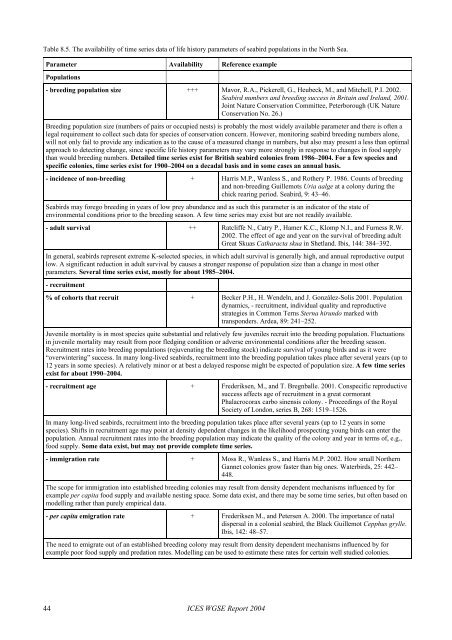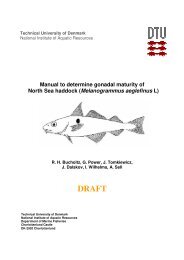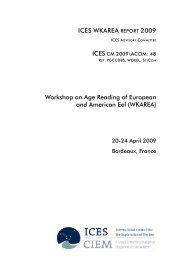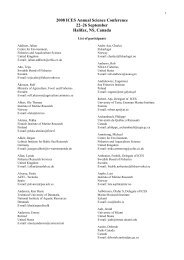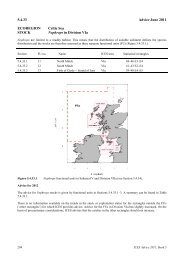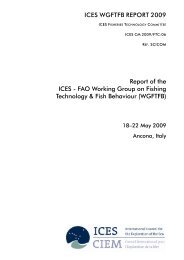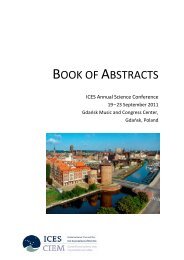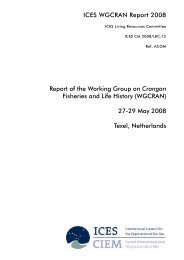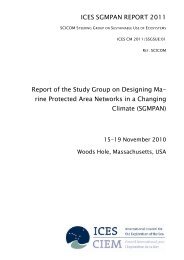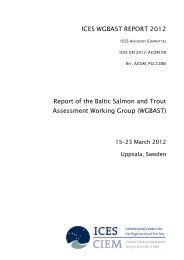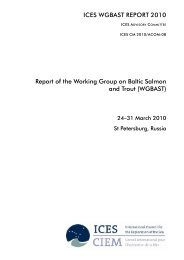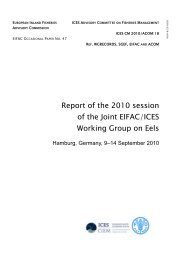Working Group on Seabird Ecology (WGSE). ICES CM 2004/C:05 ...
Working Group on Seabird Ecology (WGSE). ICES CM 2004/C:05 ...
Working Group on Seabird Ecology (WGSE). ICES CM 2004/C:05 ...
- TAGS
- seabird
- ecology
- ices
- www.ices.dk
You also want an ePaper? Increase the reach of your titles
YUMPU automatically turns print PDFs into web optimized ePapers that Google loves.
Table 8.5. The availability of time series data of life history parameters of seabird populati<strong>on</strong>s in the North Sea.<br />
Parameter Availability Reference example<br />
Populati<strong>on</strong>s<br />
- breeding populati<strong>on</strong> size +++ Mavor, R.A., Pickerell, G., Heubeck, M., and Mitchell, P.I. 2002.<br />
<strong>Seabird</strong> numbers and breeding success in Britain and Ireland, 2001.<br />
Joint Nature C<strong>on</strong>servati<strong>on</strong> Committee, Peterborough (UK Nature<br />
C<strong>on</strong>servati<strong>on</strong> No. 26.)<br />
Breeding populati<strong>on</strong> size (numbers of pairs or occupied nests) is probably the most widely available parameter and there is often a<br />
legal requirement to collect such data for species of c<strong>on</strong>servati<strong>on</strong> c<strong>on</strong>cern. However, m<strong>on</strong>itoring seabird breeding numbers al<strong>on</strong>e,<br />
will not <strong>on</strong>ly fail to provide any indicati<strong>on</strong> as to the cause of a measured change in numbers, but also may present a less than optimal<br />
approach to detecting change, since specific life history parameters may vary more str<strong>on</strong>gly in resp<strong>on</strong>se to changes in food supply<br />
than would breeding numbers. Detailed time series exist for British seabird col<strong>on</strong>ies from 1986–<strong>2004</strong>. For a few species and<br />
specific col<strong>on</strong>ies, time series exist for 1900–<strong>2004</strong> <strong>on</strong> a decadal basis and in some cases an annual basis.<br />
- incidence of n<strong>on</strong>-breeding + Harris M.P., Wanless S., and Rothery P. 1986. Counts of breeding<br />
and n<strong>on</strong>-breeding Guillemots Uria aalge at a col<strong>on</strong>y during the<br />
chick rearing period. <strong>Seabird</strong>, 9: 43–46.<br />
<strong>Seabird</strong>s may forego breeding in years of low prey abundance and as such this parameter is an indicator of the state of<br />
envir<strong>on</strong>mental c<strong>on</strong>diti<strong>on</strong>s prior to the breeding seas<strong>on</strong>. A few time series may exist but are not readily available.<br />
- adult survival ++ Ratcliffe N., Catry P., Hamer K.C., Klomp N.I., and Furness R.W.<br />
2002. The effect of age and year <strong>on</strong> the survival of breeding adult<br />
Great Skuas Catharacta skua in Shetland. Ibis, 144: 384–392.<br />
In general, seabirds represent extreme K-selected species, in which adult survival is generally high, and annual reproductive output<br />
low. A significant reducti<strong>on</strong> in adult survival by causes a str<strong>on</strong>ger resp<strong>on</strong>se of populati<strong>on</strong> size than a change in most other<br />
parameters. Several time series exist, mostly for about 1985–<strong>2004</strong>.<br />
- recruitment<br />
% of cohorts that recruit + Becker P.H., H. Wendeln, and J. G<strong>on</strong>zález-Solis 2001. Populati<strong>on</strong><br />
dynamics, - recruitment, individual quality and reproductive<br />
strategies in Comm<strong>on</strong> Terns Sterna hirundo marked with<br />
transp<strong>on</strong>ders. Ardea, 89: 241–252.<br />
Juvenile mortality is in most species quite substantial and relatively few juveniles recruit into the breeding populati<strong>on</strong>. Fluctuati<strong>on</strong>s<br />
in juvenile mortality may result from poor fledging c<strong>on</strong>diti<strong>on</strong> or adverse envir<strong>on</strong>mental c<strong>on</strong>diti<strong>on</strong>s after the breeding seas<strong>on</strong>.<br />
Recruitment rates into breeding populati<strong>on</strong>s (rejuvenating the breeding stock) indicate survival of young birds and as it were<br />
“overwintering” success. In many l<strong>on</strong>g-lived seabirds, recruitment into the breeding populati<strong>on</strong> takes place after several years (up to<br />
12 years in some species). A relatively minor or at best a delayed resp<strong>on</strong>se might be expected of populati<strong>on</strong> size. A few time series<br />
exist for about 1990–<strong>2004</strong>.<br />
- recruitment age + Frederiksen, M., and T. Bregnballe. 2001. C<strong>on</strong>specific reproductive<br />
success affects age of recruitment in a great cormorant<br />
Phalacrocorax carbo sinensis col<strong>on</strong>y. - Proceedings of the Royal<br />
Society of L<strong>on</strong>d<strong>on</strong>, series B, 268: 1519–1526.<br />
In many l<strong>on</strong>g-lived seabirds, recruitment into the breeding populati<strong>on</strong> takes place after several years (up to 12 years in some<br />
species). Shifts in recruitment age may point at density dependent changes in the likelihood prospecting young birds can enter the<br />
populati<strong>on</strong>. Annual recruitment rates into the breeding populati<strong>on</strong> may indicate the quality of the col<strong>on</strong>y and year in terms of, e.g.,<br />
food supply. Some data exist, but may not provide complete time series.<br />
- immigrati<strong>on</strong> rate + Moss R., Wanless S., and Harris M.P. 2002. How small Northern<br />
Gannet col<strong>on</strong>ies grow faster than big <strong>on</strong>es. Waterbirds, 25: 442–<br />
448.<br />
The scope for immigrati<strong>on</strong> into established breeding col<strong>on</strong>ies may result from density dependent mechanisms influenced by for<br />
example per capita food supply and available nesting space. Some data exist, and there may be some time series, but often based <strong>on</strong><br />
modelling rather than purely empirical data.<br />
- per capita emigrati<strong>on</strong> rate + Frederiksen M., and Petersen A. 2000. The importance of natal<br />
dispersal in a col<strong>on</strong>ial seabird, the Black Guillemot Cepphus grylle.<br />
Ibis, 142: 48–57.<br />
The need to emigrate out of an established breeding col<strong>on</strong>y may result from density dependent mechanisms influenced by for<br />
example poor food supply and predati<strong>on</strong> rates. Modelling can be used to estimate these rates for certain well studied col<strong>on</strong>ies.<br />
44<br />
<strong>ICES</strong> <strong>WGSE</strong> Report <strong>2004</strong>


